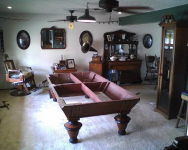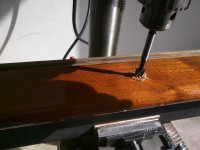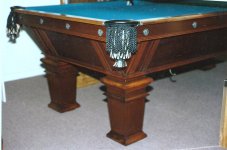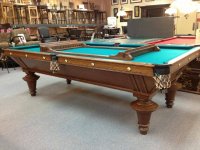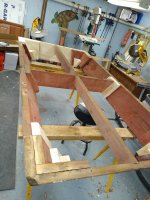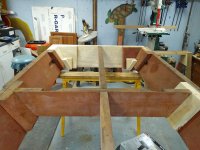Ideally, frame construction will be the most stable (move the least differentially with seasons and stay flatter at the slate support surface) if the construction of the support elements is the same.
If you ever addressed whether this is a 4 or 5 ply frame, sorry, I missed it?
There are a couple ways to veneer solid wood.
My BBC familiarity is with the Later 1920’s tables. The frame rails are glued up thick staves of poplar cross banded on both sides with thickish poplar veneers to restrain shrinkage/expansion. Then the face/feature veneer is again parallel to the long grain of the poplar core. If the assembly never sees extreme damp or humidity fluctuations it is quite stable and behaves almost like plywood so long as the cross band integrity is not compromissed.
Alternately, staves of the structural material can be glued up with feature veneer only (no cross band) applied to one side only or to both sides. This type construction behaves like solid lumber and shrinks/expands with the seasons & ambient humidity level.
If your frame rails are 4 or 5 ply, then adding plywood to both sides of the part you describe will not necessarily be compromising.
If the frame rails have no cross bands, then it might be better to use solid lumber so one part does not persist at the manufactured size while the rest of the frame shrinks and expands with the seasons. (Slate resting on the crossband rail moves up & down compared to the frame rails) if the cross rail register surface is low in the frame.
Similarly for wide solid boards everything that are supported at one edge and expected to maintain the same fluctuating width at the opposite edge among pieces needs to be the same cut. QS to QS & flat sawn to flat sawn.
For structural purposes 8/4 or 10/4 poplar and African mahogany behave about the same. Similar weight, availability,price. A.m.is coarser grain. Both have similar stability: good in straight grain especially quarter saw pieces. Less so for figured & face cuts. Northeast white pine with no knots is quite stable assuming section dimensions commensurate with load.
smt
If you ever addressed whether this is a 4 or 5 ply frame, sorry, I missed it?
There are a couple ways to veneer solid wood.
My BBC familiarity is with the Later 1920’s tables. The frame rails are glued up thick staves of poplar cross banded on both sides with thickish poplar veneers to restrain shrinkage/expansion. Then the face/feature veneer is again parallel to the long grain of the poplar core. If the assembly never sees extreme damp or humidity fluctuations it is quite stable and behaves almost like plywood so long as the cross band integrity is not compromissed.
Alternately, staves of the structural material can be glued up with feature veneer only (no cross band) applied to one side only or to both sides. This type construction behaves like solid lumber and shrinks/expands with the seasons & ambient humidity level.
If your frame rails are 4 or 5 ply, then adding plywood to both sides of the part you describe will not necessarily be compromising.
If the frame rails have no cross bands, then it might be better to use solid lumber so one part does not persist at the manufactured size while the rest of the frame shrinks and expands with the seasons. (Slate resting on the crossband rail moves up & down compared to the frame rails) if the cross rail register surface is low in the frame.
Similarly for wide solid boards everything that are supported at one edge and expected to maintain the same fluctuating width at the opposite edge among pieces needs to be the same cut. QS to QS & flat sawn to flat sawn.
For structural purposes 8/4 or 10/4 poplar and African mahogany behave about the same. Similar weight, availability,price. A.m.is coarser grain. Both have similar stability: good in straight grain especially quarter saw pieces. Less so for figured & face cuts. Northeast white pine with no knots is quite stable assuming section dimensions commensurate with load.
smt
Last edited:
